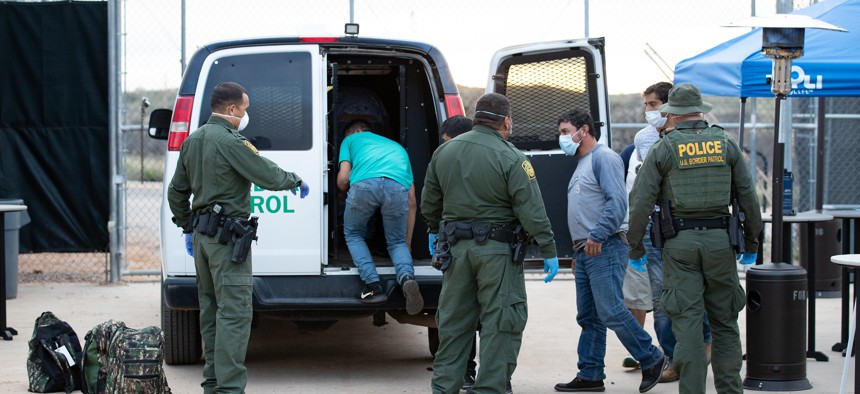
Border Patrol agents use personal protective equipment as they prepare to transport a group of individuals encountered near Sasabe, Ariz. in March. Jerry Glaser/ Customs and Border Protection
Democratic Senators Demand Answers on Trump’s Secretive Border Expulsions
After ProPublica’s report, Democrats on the Senate Judiciary Committee ask the Department of Homeland Security to explain why it thinks emergency powers granted to the CDC allow it to bypass existing asylum laws.
Democratic members of the Senate Judiciary Committee are demanding information about what they call an “unprecedented expansion of executive power” by the Trump administration at the the U.S.-Mexico border, after a ProPublica story revealed how the administration has used emergency powers to bypass asylum law and summarily expel thousands of migrants.
In a letter written by Sen. Patrick Leahy, D-Vt., he and nine colleagues give the Department of Homeland Security until April 15 to explain why it believes it can use one section of U.S. law — which gives emergency powers to the U.S. Centers for Disease Control and Prevention to prohibit the entry of people or things that might “introduce” infectious disease — to preempt the government’s obligation under another section of federal law protecting migrants fearing persecution in their home countries.
“We are deeply concerned that DHS is blatantly misinterpreting its limited authorities under the CDC’s Title 42 order to override existing federal statutes — a move with no known precedent or clear legal rationale,” the letter states. “Making matters worse, this unprecedented expansion of executive power appears to be entirely hidden from public and Congressional oversight.”
Since March 20, citing the risk of spreading the novel coronavirus in border facilities that aren’t designed for medical care, the Border Patrol has adopted a policy of pushing migrants back to Mexico as quickly as possible. Mexico has agreed to accept not only its own citizens but citizens of Guatemala, Honduras and El Salvador; the four countries make up the overwhelming majority of immigrants who cross into the U.S. without papers.
The Trump administration says that the CDC’s emergency powers, which are under Title 42 of the U.S. Code, allow it to take this approach. The CDC issued an order under Title 42 to bar unauthorized immigrants from crossing into the U.S. from Mexico without inspection.
But the Trump administration has offered few details publicly about how the operation actually works. ProPublica’s report, based on a leaked internal Border Patrol memo, offers the most complete picture to date of what the memo calls “Operation Capio.”
The memo instructs agents that in nearly all cases, people caught trying to enter the U.S. should be “expelled” under Title 42 rather than processed under existing immigration law. Migrants who fear persecution in their home countries have no ability to get humanitarian protections in the U.S., and they will be returned with no chance to explain their fears. Migrants who “spontaneously” express a fear of torture in their home countries can be allowed to stay and seek legal status in the U.S., but only if the Border Patrol agent finds their claim “reasonably believable” and gets approval from a senior official.
Customs and Border Protection and the Department of Homeland Security did not immediately respond to requests for comment. In a comment for the original story, a Customs and Border Protection spokesperson told ProPublica that agents had the authority to exempt particular migrants from expulsion for humanitarian reasons — which is contradicted by the text of the memo, as well as reports from other media outlets and briefings given to congressional staff.
In the letter, the senators say that under the plan reported by ProPublica, “executive branch officials can all but ignore the requirements of long-standing federal laws pursuant to an executive branch interpretation of a statute enacted in 1944.”
The letter asks Acting Homeland Security Secretary Chad Wolf to present the internal legal analysis showing that the CDC’s emergency powers preempt existing immigration laws — or to explain, if no such analysis exists, why the administration concluded that it could bypass federal law without a formal opinion. It also demands weekly reports detailing how many people are being expelled under this policy and how many of them are single adults, members of families or unaccompanied children.
“Operation Capio” has allowed the Trump administration to reduce the number of people held in Customs and Border Protection facilities. According to statistics circulated within the government this week, there were 408 people held in CBP facilities on April 1 — down from 3,282 on March 18.
There are an additional 35,671 immigrants being held in Immigration and Customs Enforcement detention — some of whom were apprehended crossing the border and are fighting deportation (or who cannot be deported) and some of whom were apprehended within the U.S. The novel coronavirus has spread into several ICE facilities, with 30 cases (19 detainees and 11 staff) confirmed across 16 facilities as of April 7. Under pressure from advocates and Democrats to slow the spread of the coronavirus by releasing detainees, ICE told Congress this week that it has identified about 600 medically vulnerable detainees for potential release, and that about 160 were released as of March 30.
This article was originally published in ProPublica. It has been republished under the Creative Commons license. ProPublica is a Pulitzer Prize-winning investigative newsroom. Sign up for their newsletter.






